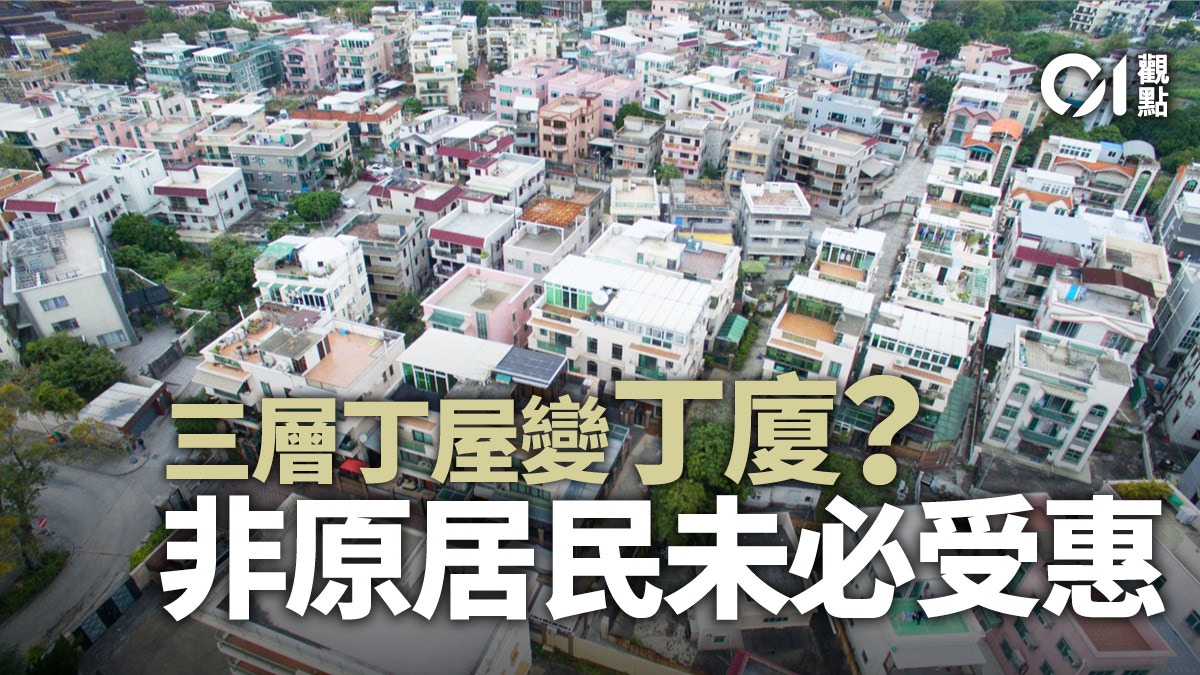This Wednesday (August 11), the representative of the Heung Yee Kuk of the New Territories submitted to the Chief Executive Carrie Lam the "Policy Address" consultation recommendations. One of the focus is on "Utilizing New Territories Land", except for the "ancestral hall" In addition to the problem, the issue of increasing the density of land for "village-style development" has been revisited. It is hoped that multi-storey "small houses" will be replaced by the current "small houses" which are limited to three floors and 700 square feet per floor. Said that the "Dingsha" to be built in the future can consider assigning some units to public housing.
The Hong Kong Government has implemented the "New Territories Small House Policy" in 1972, allowing male descendants of the original inhabitants of the New Territories to build a "small house" on the land of "village-style development" or "village expansion area" in the village to which they belong. The specifications must comply with the "Building Ordinance (Applicable to the New Territories) Ordinance", that is, no more than three floors, no more than 8.23 meters in height, and no more than 65.03 square meters of covered area.
Compared with other areas in Hong Kong, this kind of development density is naturally quite extravagant, so it is often criticized for wasting land resources.
The government has long been noncommittal
In the early years of the reunification, the Hong Kong Government reviewed the "New Territories Small House Policy", and in February 2006 it once proposed to pilot multi-storey house development in the rural expansion areas of Pai Tau, Sheung Wo Che and Xiwei New Village, and set the two highest plot ratios separately. It was set at five times and three times, but the result was not achieved because it might lead to planning and building control problems.
Since then, relevant proposals have been repeatedly raised in the market. For example, during the consultation period of the "Land Debate" in 2018, many opinions expressed that the development density of the "village-style development" zone should be increased, and even directly requested the abolition of "Ding Quan" or called for " "Ding Quan Cuts the Dragon" to free up land for other purposes.
The government announced earlier that 1,201.2 hectares of land is reserved for "village-type development" in Hong Kong. After deducting roads/access, man-made slopes and simple temporary land allocation, the remaining land is 932.9 hectares.
(Profile picture)
What is strange is that the authorities have turned a deaf ear to these voices in recent years and have not taken active follow-up actions.
In April 2015, at the special meeting of the Finance Committee of the Legislative Council to review the expenditure budget, the Permanent Secretary for Development Chow Tat-ming stated that the construction of multi-storey houses on rural land has "planning control, environmental impact and other issues that need to be reviewed and dealt with." "; As of November 2018, the Secretary for Development, Wong Wai-lun, responded to the question raised by the Heung Yee Kuk subsector Liu Yeqiang in the Legislative Council meeting. He still only said that the construction of multi-storey small houses would inevitably involve a number of complex issues... such as exploring the relevant proposals, These issues must be fully considered," during which there seemed to be little progress.
Ding Xia is difficult to make the final plan
In all fairness, multi-storey "Dingsha" may temporarily improve the land use efficiency of "village-style development", but the infrastructure facilities in most rural areas cannot support a substantial increase in development density at present. At best, three-story buildings can only be increased to ten. It’s only about 20 or so floors. In the long run, it’s still hard to make good use of land resources. As for the allocation of some units in the "Dingxia" to public housing, it is obviously not considered that the original inhabitants, squires and outsiders tend to have conflicts.
This shows that "Dingxia" is at best a transitional plan, and it is difficult to make a lasting solution.
More importantly, the report of the Task Force on Land Supply after the "Land Debate" has long stated clearly that "From the perspective of making the best use of land, the government can consider whether the small house policy is There is room for review," the Hong Kong Government responded by saying that "it is aware of the task force's observation of this option" and "will continue to monitor the development of judicial review of the small house policy."
With the "Cheung Chau King of Review" Guo Zhuojian earlier decided to abandon the appeal of the case to the Court of Final Appeal, the relevant procedures have logically been completed, and it is time for the Hong Kong government to fulfill its promise to review the entire "small house" policy.
Guo Zhuojian and social worker Lu Zhiheng filed a judicial review on Ding Quan and the small house policy.
(Profile picture)
Moreover, whether "small houses" or "ding houses", they essentially discriminate against female indigenous and non-indigenous inhabitants. This is recognized even in the appeal court decision itself.
A policy that only allows male indigenous inhabitants to enjoy the "right" is bound to be unfair to other members of society.
Changing the "small houses" acquired by males to "ding houses" can reduce the area of land they occupy, but it also means that more male aboriginals can continue to enjoy the "rights" and cannot solve the current unfairness. Phenomenon.
As a plan to balance the supply of land in Hong Kong with the rights and interests of the indigenous inhabitants, the multi-storey "Dingxia" undoubtedly has certain merits. However, as "Hong Kong 01" has repeatedly emphasized in the past, the privilege of "Ding rights" is impossible in itself. Restrictions continue, especially when central officials are increasingly concerned about the land and housing problems in Hong Kong. In addition to considering the use of "Dingxia" instead of "small houses," all parties need to carefully review the existence and abolition of the "Ding rights" policy. Macroscopic issues such as the layout of indigenous villages and the development planning of the entire New Territories can be regarded as really helpful in solving the land shortage in the long run.
The legal process has come to an end. The small house problem has yet to be resolved by the government. It is advisable to relax the resale of ancestral halls, but when a management mechanism is in place, when will the Hong Kong government tolerate the raising of "small houses"?













/cloudfront-eu-central-1.images.arcpublishing.com/prisa/KMEYMJKESBAZBE4MRBAM4TGHIQ.jpg)

